Stellar evolution

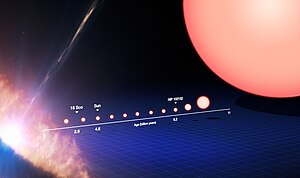
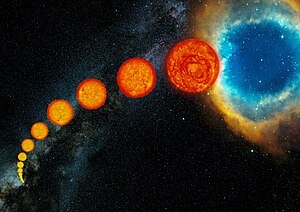
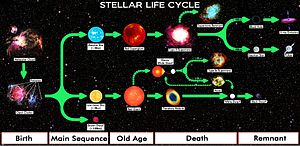
Stellar evolution is the process by which a star changes over the course of time. Depending on the mass of the star, its lifetime can range from a few million years for the most massive to trillions of years for the least massive, which is considerably longer than the current age of the universe. The table shows the lifetimes of stars as a function of their masses.[1] All stars are formed from collapsing clouds of gas and dust, often called nebulae or molecular clouds. Over the course of millions of years, these protostars settle down into a state of equilibrium, becoming what is known as a main-sequence star.
Stellar evolution is not studied by observing the life of a single star, as most stellar changes occur too slowly to be detected, even over many centuries. Instead, astrophysicists come to understand how stars evolve by observing numerous stars at various points in their lifetime, and by simulating
Star formation

Protostar
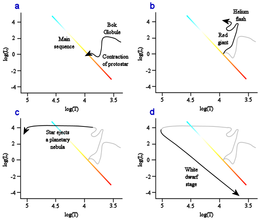
Stellar evolution starts with the
A protostar continues to grow by accretion of gas and dust from the molecular cloud, becoming a pre-main-sequence star as it reaches its final mass. Further development is determined by its mass. Mass is typically compared to the mass of the Sun: 1.0 M☉ (2.0×1030 kg) means 1 solar mass.
Protostars are encompassed in dust, and are thus more readily visible at infrared wavelengths. Observations from the Wide-field Infrared Survey Explorer (WISE) have been especially important for unveiling numerous galactic protostars and their parent star clusters.[5][6]
Brown dwarfs and sub-stellar objects
Protostars with masses less than roughly 0.08 M☉ (1.6×1029 kg) never reach temperatures high enough for
Main sequence stellar mass objects
For a more-massive protostar, the core temperature will eventually reach 10 million
A new star will sit at a specific point on the main sequence of the
Planetary system

A star may gain a protoplanetary disk, which furthermore can develop into a planetary system.
Mature stars
Eventually the star's core exhausts its supply of hydrogen and the star begins to evolve off the
Low-mass stars
What happens after a low-mass star ceases to produce energy through fusion has not been directly observed; the universe is around 13.8 billion years old, which is less time (by several orders of magnitude, in some cases) than it takes for fusion to cease in such stars.
Recent astrophysical models suggest that red dwarfs of 0.1 M☉ may stay on the main sequence for some six to twelve trillion years, gradually increasing in both temperature and luminosity, and take several hundred billion years more to collapse, slowly, into a white dwarf.[9][10] Such stars will not become red giants as the whole star is a convection zone and it will not develop a degenerate helium core with a shell burning hydrogen. Instead, hydrogen fusion will proceed until almost the whole star is helium.
Slightly more
Mid-sized stars
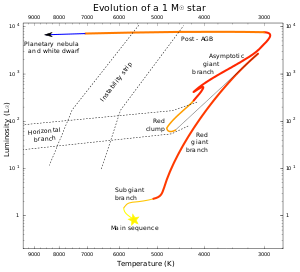
Stars of roughly 0.6–10 M☉ become red giants, which are large non-main-sequence stars of stellar classification K or M. Red giants lie along the right edge of the Hertzsprung–Russell diagram due to their red color and large luminosity. Examples include Aldebaran in the constellation Taurus and Arcturus in the constellation of Boötes.
Mid-sized stars are red giants during two different phases of their post-main-sequence evolution: red-giant-branch stars, with inert cores made of helium and hydrogen-burning shells, and asymptotic-giant-branch stars, with inert cores made of carbon and helium-burning shells inside the hydrogen-burning shells.[12] Between these two phases, stars spend a period on the horizontal branch with a helium-fusing core. Many of these helium-fusing stars cluster towards the cool end of the horizontal branch as K-type giants and are referred to as red clump giants.
Subgiant phase
When a star exhausts the hydrogen in its core, it leaves the main sequence and begins to fuse hydrogen in a shell outside the core. The core increases in mass as the shell produces more helium. Depending on the mass of the helium core, this continues for several million to one or two billion years, with the star expanding and cooling at a similar or slightly lower luminosity to its main sequence state. Eventually either the core becomes degenerate, in stars around the mass of the sun, or the outer layers cool sufficiently to become opaque, in more massive stars. Either of these changes cause the hydrogen shell to increase in temperature and the luminosity of the star to increase, at which point the star expands onto the red-giant branch.[13]
Red-giant-branch phase
The expanding outer layers of the star are
The helium core continues to grow on the red-giant branch. It is no longer in thermal equilibrium, either degenerate or above the Schönberg–Chandrasekhar limit, so it increases in temperature which causes the rate of fusion in the hydrogen shell to increase. The star increases in luminosity towards the tip of the red-giant branch. Red-giant-branch stars with a degenerate helium core all reach the tip with very similar core masses and very similar luminosities, although the more massive of the red giants become hot enough to ignite helium fusion before that point.
Horizontal branch
In the helium cores of stars in the 0.6 to 2.0 solar mass range, which are largely supported by
Core helium flash stars evolve to the red end of the horizontal branch but do not migrate to higher temperatures before they gain a degenerate carbon-oxygen core and start helium shell burning. These stars are often observed as a
Asymptotic-giant-branch phase
After a star has consumed the helium at the core, hydrogen and helium fusion continues in shells around a hot core of
There is a phase on the ascent of the asymptotic-giant-branch where a deep convective zone forms and can bring carbon from the core to the surface. This is known as the second dredge up, and in some stars there may even be a third dredge up. In this way a carbon star is formed, very cool and strongly reddened stars showing strong carbon lines in their spectra. A process known as hot bottom burning may convert carbon into oxygen and nitrogen before it can be dredged to the surface, and the interaction between these processes determines the observed luminosities and spectra of carbon stars in particular clusters.[19]
Another well known class of asymptotic-giant-branch stars is the Mira variables, which pulsate with well-defined periods of tens to hundreds of days and large amplitudes up to about 10 magnitudes (in the visual, total luminosity changes by a much smaller amount). In more-massive stars the stars become more luminous and the pulsation period is longer, leading to enhanced mass loss, and the stars become heavily obscured at visual wavelengths. These stars can be observed as OH/IR stars, pulsating in the infrared and showing OH maser activity. These stars are clearly oxygen rich, in contrast to the carbon stars, but both must be produced by dredge ups.
Post-AGB
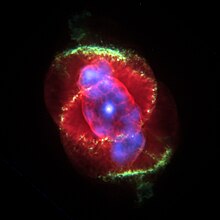
These mid-range stars ultimately reach the tip of the asymptotic-giant-branch and run out of fuel for shell burning. They are not sufficiently massive to start full-scale carbon fusion, so they contract again, going through a period of post-asymptotic-giant-branch superwind to produce a planetary nebula with an extremely hot central star. The central star then cools to a white dwarf. The expelled gas is relatively rich in heavy elements created within the star and may be particularly oxygen or carbon enriched, depending on the type of the star. The gas builds up in an expanding shell called a circumstellar envelope and cools as it moves away from the star, allowing dust particles and molecules to form. With the high infrared energy input from the central star, ideal conditions are formed in these circumstellar envelopes for maser excitation.
It is possible for thermal pulses to be produced once post-asymptotic-giant-branch evolution has begun, producing a variety of unusual and poorly understood stars known as born-again asymptotic-giant-branch stars.
Massive stars

In massive stars, the core is already large enough at the onset of the hydrogen burning shell that helium ignition will occur before electron degeneracy pressure has a chance to become prevalent. Thus, when these stars expand and cool, they do not brighten as dramatically as lower-mass stars; however, they were more luminous on the main sequence and they evolve to highly luminous supergiants. Their cores become massive enough that they cannot support themselves by
Supergiant evolution
Extremely massive stars (more than approximately 40 M☉), which are very luminous and thus have very rapid stellar winds, lose mass so rapidly due to radiation pressure that they tend to strip off their own envelopes before they can expand to become red supergiants, and thus retain extremely high surface temperatures (and blue-white color) from their main-sequence time onwards. The largest stars of the current generation are about 100-150 M☉ because the outer layers would be expelled by the extreme radiation. Although lower-mass stars normally do not burn off their outer layers so rapidly, they can likewise avoid becoming red giants or red supergiants if they are in binary systems close enough so that the companion star strips off the envelope as it expands, or if they rotate rapidly enough so that convection extends all the way from the core to the surface, resulting in the absence of a separate core and envelope due to thorough mixing.[21]

The core of a massive star, defined as the region depleted of hydrogen, grows hotter and denser as it accretes material from the fusion of hydrogen outside the core. In sufficiently massive stars, the core reaches temperatures and densities high enough to fuse carbon and heavier elements via the
The exact mass limit for full carbon burning depends on several factors such as metallicity and the detailed mass lost on the
In more massive stars, the fusion of neon proceeds without a runaway deflagration. This is followed in turn by complete oxygen burning and
Supernova
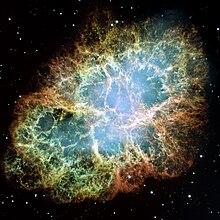
When the core of a massive star collapses, it will form a
The energy transferred from collapse of the core to rebounding material not only generates heavy elements, but provides for their acceleration well beyond escape velocity, thus causing a Type Ib, Type Ic, or Type II supernova. Current understanding of this energy transfer is still not satisfactory; although current computer models of Type Ib, Type Ic, and Type II supernovae account for part of the energy transfer, they are not able to account for enough energy transfer to produce the observed ejection of material.[26] However, neutrino oscillations may play an important role in the energy transfer problem as they not only affect the energy available in a particular flavour of neutrinos but also through other general-relativistic effects on neutrinos.[27][28]
Some evidence gained from analysis of the mass and orbital parameters of binary neutron stars (which require two such supernovae) hints that the collapse of an oxygen-neon-magnesium core may produce a supernova that differs observably (in ways other than size) from a supernova produced by the collapse of an iron core.[29]
The most massive stars that exist today may be completely destroyed by a supernova with an energy greatly exceeding its gravitational binding energy. This rare event, caused by pair-instability, leaves behind no black hole remnant.[30] In the past history of the universe, some stars were even larger than the largest that exists today, and they would immediately collapse into a black hole at the end of their lives, due to photodisintegration.
Stellar remnants

After a star has burned out its fuel supply, its remnants can take one of three forms, depending on the mass during its lifetime.
White and black dwarfs
For a star of 1 M☉, the resulting white dwarf is of about 0.6 M☉, compressed into approximately the volume of the Earth. White dwarfs are stable because the inward pull of gravity is balanced by the
A white dwarf is very hot when it first forms, more than 100,000 K at the surface and even hotter in its interior. It is so hot that a lot of its energy is lost in the form of neutrinos for the first 10 million years of its existence and will have lost most of its energy after a billion years.[31]
The chemical composition of the white dwarf depends upon its mass. A star that has a mass of about 8-12 solar masses will ignite
In the end, all that remains is a cold dark mass sometimes called a black dwarf. However, the universe is not old enough for any black dwarfs to exist yet.
If the white dwarf's mass increases above the
If a white dwarf forms a close binary system with another star, hydrogen from the larger companion may accrete around and onto a white dwarf until it gets hot enough to fuse in a runaway reaction at its surface, although the white dwarf remains below the Chandrasekhar limit. Such an explosion is termed a nova.
Neutron stars

Ordinarily, atoms are mostly electron clouds by volume, with very compact nuclei at the center (proportionally, if atoms were the size of a football stadium, their nuclei would be the size of dust mites). When a stellar core collapses, the pressure causes electrons and protons to fuse by electron capture. Without electrons, which keep nuclei apart, the neutrons collapse into a dense ball (in some ways like a giant atomic nucleus), with a thin overlying layer of degenerate matter (chiefly iron unless matter of different composition is added later). The neutrons resist further compression by the Pauli exclusion principle, in a way analogous to electron degeneracy pressure, but stronger.
These stars, known as neutron stars, are extremely small—on the order of radius 10 km, no bigger than the size of a large city—and are phenomenally dense. Their period of rotation shortens dramatically as the stars shrink (due to
Black holes
If the mass of the stellar remnant is high enough, the neutron degeneracy pressure will be insufficient to prevent collapse below the Schwarzschild radius. The stellar remnant thus becomes a black hole. The mass at which this occurs is not known with certainty, but is currently estimated at between 2 and 3 M☉.
Black holes are predicted by the theory of general relativity. According to classical general relativity, no matter or information can flow from the interior of a black hole to an outside observer, although quantum effects may allow deviations from this strict rule. The existence of black holes in the universe is well supported, both theoretically and by astronomical observation.
Because the core-collapse mechanism of a supernova is, at present, only partially understood, it is still not known whether it is possible for a star to collapse directly to a black hole without producing a visible supernova, or whether some supernovae initially form unstable neutron stars which then collapse into black holes; the exact relation between the initial mass of the star and the final remnant is also not completely certain. Resolution of these uncertainties requires the analysis of more supernovae and supernova remnants.
Models
A stellar evolutionary model is a
See also
- Compact star– Classification in astronomy
- Galaxy formation and evolution – From a homogeneous beginning, the formation of the first galaxies, the way galaxies change over time
- Chronology of the universe – History and future of the universe
- Nucleosynthesis – Process that creates new atomic nuclei from pre-existing nucleons, primarily protons and neutrons
- Standard solar model – Theoretical framework detailing the sun's structure, composition and energetics
- Stellar population – Grouping of stars by similar metallicity (metallicity)
- Stellar rotation § After formation – Angular motion of a star about its axis – Rotations slow as stars age
- Timeline of stellar astronomy
References
- ISBN 978-981-4417-66-2.
- ^ doi:10.1086/304125.
- ^ Prialnik (2000, Chapter 10)
- S2CID 211126855.
- ^ "Wide-field Infrared Survey Explorer Mission". NASA.
- ^ Majaess, D. (2013). Discovering protostars and their host clusters via WISE, ApSS, 344, 1 (VizieR catalog)
- ^ "Working Group on Extrasolar Planets: Definition of a "Planet"". IAU position statement. 2003-02-28. Archived from the original on February 4, 2012. Retrieved 2012-05-30.
- ^ Prialnik (2000, Fig. 8.19, p. 174)
- ^ "Why the Smallest Stars Stay Small". Sky & Telescope (22). November 1997.
- .
- ^ Lejeune, T; Schaerer, D (2001). "Database of Geneva stellar evolution tracks and isochrones for , HST-WFPC2, Geneva and Washington photometric systems". Astronomy & Astrophysics. 366 (2): 538–546. S2CID 6708419.
- ^ Hansen, Kawaler & Trimble (2004, pp. 55–56)
- ^ a b c Ryan & Norton (2010, p. 115)
- ^ Ryan & Norton (2010, p. 125)
- ^ a b Prialnik (2000, p. 151)
- S2CID 15585754.
- S2CID 55701280.
- doi:10.1086/173407.
- .
- Bibcode:1991IAUS..145..363H.
- S2CID 189933559.
- ^ S2CID 118687195.
- ^ S2CID 55932331.
- doi:10.1086/165716.
- ^ How do Massive Stars Explode? Archived 2003-06-27 at the Wayback Machine
- ^ Robert Buras; et al. (June 2003). "Supernova Simulations Still Defy Explosions". Research Highlights. Max-Planck-Institut für Astrophysik. Archived from the original on 2003-08-03.
- S2CID 1045277.
- S2CID 119190550.
- Bibcode:2004ESASP.552..185V.
- ^ Pair Instability Supernovae and Hypernovae., Nicolay J. Hammer, (2003), accessed May 7, 2007. Archived June 8, 2012, at the Wayback Machine
- ^ "Fossil Stars (1): White Dwarfs".
- doi:10.1086/161749.
- doi:10.1086/185922.
- .
- ^ Courtland, Rachel (17 October 2008). "Pulsar Detected by Gamma Waves Only". New Scientist. Archived from the original on April 2, 2013.
- S2CID 14254892.
- ^ Ryan & Norton (2010, p. 79, "Assigning ages from hydrogen-burning timescales")
- Hansen, Carl J.; Kawaler, Steven D.; Trimble, Virginia (2004). Stellar interiors: physical principles, structure, and evolution (2nd ed.). Springer-Verlag. ISBN 0-387-20089-4.
- Prialnik, Dina (2000). An Introduction to the Theory of Stellar Structure and Evolution. Cambridge University Press. ISBN 0-521-65065-8.
- Ryan, Sean G.; Norton, Andrew J. (2010). Stellar Evolution and Nucleosynthesis. Cambridge University Press. ISBN 978-0-521-13320-3.
Further reading
- Ekström, S.; Georgy, C.; Eggenberger, P.; Meynet, G.; Mowlavi, N.; Wyttenbach, A.; Granada, A.; Decressin, T.; Hirschi, R.; Frischknecht, U.; Charbonnel, C.; Maeder, A. (2012). "Grids of stellar models with rotation". Astronomy & Astrophysics. 537: A146. S2CID 85458919.
- Astronomy 606 (Stellar Structure and Evolution) lecture notes, Cole Miller, Department of Astronomy, University of Maryland
- Astronomy 162, Unit 2 (The Structure & Evolution of Stars) lecture notes, Richard W. Pogge, Department of Astronomy, Ohio State University
External links
- Stellar evolution simulator
- Pisa Stellar Models
- MESA stellar evolution codes (Modules for Experiments in Stellar Astrophysics)
- "The Life of Stars", BBC Radio 4 discussion with Paul Murdin, Janna Levin and Phil Charles (In Our Time, Mar. 27, 2003)
- Life cycle of a star [1] [2]


